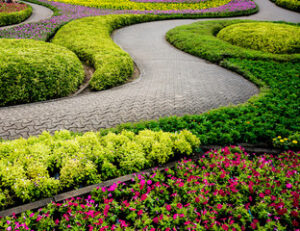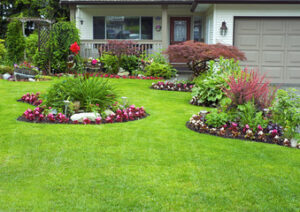Florence Landscaping is the art of designing and maintaining gardens for aesthetic and functional purposes. It includes adding plants, changing the terrain and constructing structures such as fences, patios and walls.

Focus on unity and pacing when creating your landscape. For example, if you want to draw attention to a statue in your yard, reduce clutter and surround it with colors that coordinate well.
Incorporating eco friendly landscaping practices into your property can help you to save money on energy bills, protect the environment and attract wildlife. This type of landscaping takes into account several goals such as water conservation, soil health and promoting biodiversity.
Choosing plants that are native to your area is the first step in creating an environmentally friendly landscape. They are accustomed to the climate and require less watering than non-native plants. They also provide food and shelter for local insects, birds and animals. Planting indigenous trees, shrubs and grasses can help to prevent soil erosion during storms or heavy rain. The use of organic fertilizers and natural pest controls can help to reduce the amount of chemical runoff into lakes, rivers and streams.
Another aspect of an eco-friendly landscape is the use of permeable hardscaping like gravel or pavers in place of concrete. This allows water to soak into the ground rather than running off into storm sewers, rivers and lakes. Incorporating organic mulch into the garden can improve soil health and retain moisture, which will reduce maintenance needs. Planting deciduous trees (that shed their leaves in winter) and utilizing a variety of native flowers that bloom throughout the year, can provide shade, privacy, attract pollinators, promote biodiversity and reduce your carbon footprint.
Planting windbreak trees can help to reduce your air conditioning costs by 35%. Watering the garden with drip irrigation or using rain barrels can help to conserve water resources. Watering in the early morning can reduce evaporation and decrease your water bill. Planting low-maintenance perennials that don’t need to be replanted every year, can reduce your gardening time and expense.
Maintaining a well-kept, functional outdoor space can add to your enjoyment of your home and increase the value of your property when it comes time to sell. It can also be a source of healthy food for you and your family. Many people find stress relief in gardening and spending time outdoors. Studies have shown that eco-friendly landscaping can reduce anxiety and depression by providing a quiet place to relax, unwind and recharge.
Increases Property Value
Many homeowners are looking for ways to increase the resale value of their homes. While a home remodel and square footage additions are great options, sometimes they aren’t in the budget. However, a well-groomed yard and manicured landscape can be an inexpensive way to boost property value.
According to the Appraisal Institute, a well-maintained landscape can add 6 to 13 percent to a property’s value. Having lush green grass, trimmed shrubs and trees, and fresh mulch will make a positive first impression for potential buyers. A professionally designed and executed landscape can separate a home from its competition in the market, increasing its value and curb appeal.
Incorporating hardscaping elements such as pathways, retaining walls and decorative features can also enhance your property’s appearance and value. These features are a great way to create defined outdoor spaces, accentuate focal points and create ambiance after dark.
Curb appeal is one of the most important factors when a homeowner decides to sell their home. Having lush grass, trimmed shrubs and trees, fresh mulch, and attractively placed accent features will make a good first impression for potential buyers.
Adding a garden, patio or deck to your home is another way to add value to your property. This outdoor space is a place where family and friends can gather and enjoy the beauty of nature. It can be a peaceful and relaxing place to read, listen to music or watch the birds and squirrels play.
Studies have shown that the mere sight of plants can lower stress levels, improve attention and memory, and promote relaxation. Even city dwellers can reap these benefits by spending time in green spaces, such as parks and gardens. Landscaping increases the quality of life in urban areas by capturing dust and smoke, reducing air temperatures, producing oxygen, and removing carbon dioxide.
The landscaping industry is a multi-billion dollar business, employing over 2.5 million people in the United States. Unfortunately, mental health problems are a serious concern for this sector of the economy, and are a particular issue for people working outdoors. A lot of the work that is involved in this type of employment consists of manual labour, and can be quite physically demanding. The stress that is associated with the industry can lead to a number of issues including low self-esteem, substance abuse and depression.
Reduces Stress
Studies have shown that plants and greenery reduce stress levels in humans. This is probably because plants emit oxygen and reduce carbon dioxide, creating a healthy, natural environment that promotes relaxation and well-being. It is also possible that simply interacting with greenery, even in the form of a beautiful landscape, helps people to focus and improves their ability to solve problems. In addition to this, the calming effect of green spaces and nature can help lower blood pressure.
Landscaping is a creative and rewarding job that can give you a sense of accomplishment. However, it is important to remember that landscaping is a physical and sometimes stressful job. It is important to take time off from the job to relax and recharge. It is also important to eat healthily and get enough sleep. This will help keep you productive and happy at work.
Volunteer landscaping projects can reduce stress and anxiety by allowing individuals to connect with nature. Spending time in nature has been shown to reduce symptoms of depression and anxiety, improve mood, and promote well-being. Additionally, volunteering allows people to get out of the house and exercise. This is an excellent way to increase self-esteem and improve mental health.
Maintaining a healthy, attractive landscape requires regular care. This can be a challenge for busy homeowners. However, the benefits of a healthy lawn are numerous. Besides improving the look of your home, it can also boost your property value and make it more appealing to potential buyers. Additionally, it can help prevent soil erosion and flooding.
Grass and trees are crucial for the environment. They provide shelter for wildlife, absorb excess water, and provide a source of clean air. In fact, one tree can produce enough oxygen for four people every day. It is important to protect your yard and the environment by planting trees, reducing pesticide use, and using native plants.
Landscapers often work alone, which can lead to feelings of isolation. However, there are many communities that landscapers can join to support each other and share their expertise. For example, Lawncare Legends is an online community for landscapers to discuss their concerns and encourage each other.
Adds Value to Your Home
When it comes to home improvement projects, most people think of painting the interior or getting a new roof. However, landscaping is another excellent way to boost your property’s value and add a touch of class. According to the Appraisal Institute, homes with well-maintained landscaping can be worth up to 12% more than those without.
Landscaping can also improve a property’s curb appeal, which is a huge selling point for potential buyers. A lot of homebuyers will base their decision on whether or not a house is right for them from the moment they see it from the street. Having a lush, manicured lawn and well-placed plants will give the property an attractive appearance and make it stand out from its competition.
The plants that are planted can also help improve a home’s energy efficiency. They can block out noise and sunlight, which will keep the inside of the house cooler in the summer and warmer in the winter. Professional landscapers know how to properly place trees, shrubs, and plants for maximum benefits to a property’s energy bills.
In addition to planting, there are other elements that can be included in a landscape design such as walkways, retaining walls, and outdoor lighting. These features can create functional spaces for entertaining and relaxing, control erosion, and enhance a space’s visual appeal.
Landscape design can also include the use of color to set a particular mood for a space. Warm colors like red, yellow, and orange can make a space feel welcoming and energetic, while cool colors like blue, green, and purple can evoke feelings of tranquility.
While many homeowners may not be ready to sell their home, it’s important to consider how their property might look to someone else down the road. When you’re preparing to put your home on the market, having a great yard will leave a positive impression on potential buyers and can even help it sell faster.
Investing in quality landscaping will not only increase your property value, but it can also make your life at home more enjoyable and reduce stress levels. With all the benefits, it’s hard to imagine why you wouldn’t want to take advantage of this incredible opportunity!

